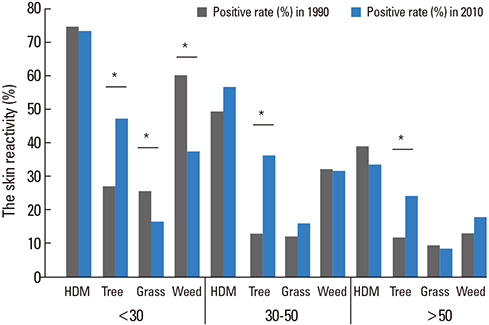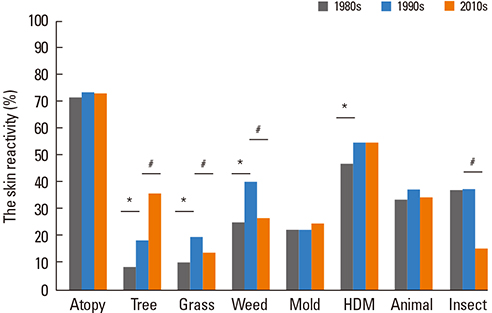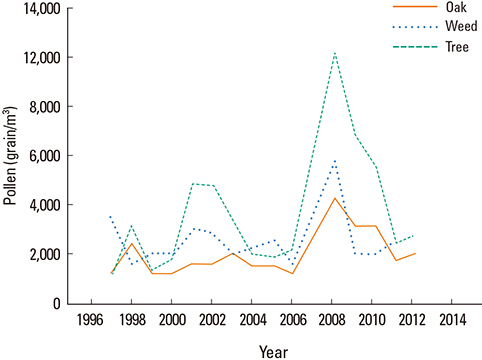Changes in Allergen Sensitization Over The Last 30 Years in Korea Respiratory Allergic Patients: A Single-Center
- Affiliations
-
- 1Division of Allergy and Immunology, Department of Internal Medicine, Yonsei University College of Medicine, Seoul, Korea. cshong@yuhs.ac
- 2Institute of Allergy, Yonsei University College of Medicine, Seoul, Korea.
- 3Biomedical Research Center, Yonsei University College of Medicine, Seoul, Korea.
- KMID: 2181080
- DOI: http://doi.org/10.4168/aair.2014.6.5.434
Abstract
- PURPOSE
Determining the culprit allergen is important for the diagnosis and management of allergic diseases. The skin prick test (SPT) has been widely used to identify culprit allergens. Skin reactivity to allergens has changed due to changes in lifestyle and outdoor environments. Therefore, the aim of the present paper was to examine changes in allergen sensitization in Korea.
METHODS
We enrolled 1,135 patients with respiratory allergic diseases who were diagnosed at Severance Hospital from January 2010 to December 2011. SPTs were performed with inhalant allergens, and were compared to our previous studies of the SPTs in the 1980s and the 1990s.
RESULTS
In the 2010s, the SPT positive rate of allergic rhinitis or allergic conjunctivitis was higher than asthma without allergic rhinitis or allergic conjunctivitis. The SPT positive rate was decreased by increments of age (P value <0.01). Skin reactivity to tree pollens was significantly increased to 36.4% in the 2010s from 19.0% in the 1990s and 8.8% in the 1980s. Among tree pollens, skin reactivity to oak (4.7%->14.4%), birch (7.1%->13.6%), alder (6.3%->13.4%) and pine (2.9%->14.3%) was significantly increased in the 2010s compared with the 1990s, respectively. Current skin reactivity to grass pollens (13.9%) and weed pollens (27.0%) has significantly decreased since the 1990s (20.3%, 40.9%, respectively). Skin reactivity to house dust mites showed no difference between the 1990s (55.2%) and the 2010s (55.6%). Skin reactivity to dog (27.3%->20.7%) and cockroach (25.3%->12.3%) have significantly decreased in the 2010s in comparison with the 1990s.
CONCLUSIONS
In light of the above results, we revealed the changes in skin reactivity to inhalant allergens that have occurred in Korean allergic patients over the past three decades. Since outdoor environmental factors such as the amount of pollen, global warming and plant distribution causes the changes in skin reactivity, further study and continuous close observation will be needed.
MeSH Terms
Figure
Cited by 16 articles
-
Gene-Environment Interactions in Asthma: Genetic and Epigenetic Effects
Jong-Uk Lee, Jeong Dong Kim, Choon-Sik Park
Yonsei Med J. 2015;56(4):877-886. doi: 10.3349/ymj.2015.56.4.877.A Six-Year Study on the Changes in Airborne Pollen Counts and Skin Positivity Rates in Korea: 2008–2013
Hye Jung Park, Jae-Hyun Lee, Kyung Hee Park, Kyu Rang Kim, Mae Ja Han, Hosoeng Choe, Jae-Won Oh, Chein-Soo Hong
Yonsei Med J. 2016;57(3):714-720. doi: 10.3349/ymj.2016.57.3.714.Clinical diagnostic guidelines for allergic rhinitis: diagnosis
Young Hyo Kim, Hyeon-Jong Yang, Jeong-Hee Choi, Dong-Kyu Kim, Young Yoo, Bora Lee, Mi-Ae Kim, Bong-Seong Kim, Won-Young Kim, Jeong Hee Kim, Yang Park, So Yeon Park, Woo Yong Bae, Keejae Song, Min-Suk Yang, Sang Min Lee, Young-Mok Lee, Hyun Jong Lee, Jae-Hong Cho, Hye Mi Jee, Young-Il Koh,
J Korean Med Assoc. 2017;60(1):81-88. doi: 10.5124/jkma.2017.60.1.81.House Dust Mite Allergy Under Changing Environments
Nathalie Acevedo, Josefina Zakzuk, Luis Caraballo
Allergy Asthma Immunol Res. 2019;11(4):450-469. doi: 10.4168/aair.2019.11.4.450.Tree Pollen Sensitization and Cross-Reaction of Children with Allergic Rhinitis or Asthma
Ye Jin Park, Yoon Ha Hwang
Kosin Med J. 2019;34(2):126-137. doi: 10.7180/kmj.2019.34.2.126.Pollen allergy plants in Korea
Chein-Soo Hong
Allergy Asthma Respir Dis. 2015;3(4):239-254. doi: 10.4168/aard.2015.3.4.239.Association between the serum 25-hydroxyvitamin D level and allergic rhinitis in Korean children
Seo Hee Yoon, Jung Yoon Kim, Yoon Hee Kim, Young A Park, In Suk Sol, Min Jung Kim, Kyung Won Kim, Myung Hyun Sohn, Kyu-Earn Kim
Allergy Asthma Respir Dis. 2016;4(6):423-428. doi: 10.4168/aard.2016.4.6.423.Changes in skin reactivity and associated factors in patients sensitized to house dust mites after 1 year of allergen-specific immunotherapy
Jeong-Yeop Son, Mann-Hong Jung, Kwang-Wook Koh, Eun-Kee Park, Jeong-Hoon Heo, Gil-Soon Choi, Hee-Kyoo Kim
Asia Pac Allergy. 2017;7(2):82-91. doi: 10.5415/apallergy.2017.7.2.82.Clinical Implications of Single Nucleotide Polymorphisms in Diagnosis of Asthma and its Subtypes
Jong-Sook Park, Ji-Hye Son, Choon-Sik Park, Hun Soo Chang
Yonsei Med J. 2019;60(1):1-9. doi: 10.3349/ymj.2019.60.1.1.Clinical Manifestations and Risk Factors of Anaphylaxis in Pollen-Food Allergy Syndrome
Minji Kim, Youngmin Ahn, Young Yoo, Dong-Kyu Kim, Hyeon-Jong Yang, Hae-Sim Park, Hyun Jong Lee, Mi-Ae Kim, Yi Yeong Jeong, Bong-Seong Kim, Woo Yong Bae, An-Soo Jang, Yang Park, Young-Il Koh, Jaechun Lee, Dae Hyun Lim, Jeong Hee Kim, Sang Min Lee, Yong Min Kim, Young Joon Jun, Hyo Yeol Kim, Yunsun Kim, Jeong-Hee Choi,
Yonsei Med J. 2019;60(10):960-968. doi: 10.3349/ymj.2019.60.10.960.Prevalence of Self-reported Allergic Diseases and IgE Levels: A 2010 KNHANES Analysis
Hye Jung Park, Eun-Jin Kim, Dankyu Yoon, Jeom Kyu Lee, Woo-Sung Chang, Yoen-Mi Lim, Jung-Won Park, Joo-Shil Lee
Allergy Asthma Immunol Res. 2017;9(4):329-339. doi: 10.4168/aair.2017.9.4.329.Patterns of Inhalant Allergen Sensitization and Geographical Variation in Korean Adults: A Multicenter Retrospective Study
Min-Gyu Kang, Mi-Yeong Kim, Woo-Jung Song, Sujeong Kim, Eun-Jung Jo, Seung-Eun Lee, Jae-Woo Kwon, Sang-Min Lee, Chan-Sun Park, Hye-Kyung Park, Heung-Woo Park, Yoon-Seok Chang, Jaechun Lee, Young-Min Lee, Young-Koo Jee, Jong-Myung Lee, Inseon S. Choi, Sang-Heon Cho
Allergy Asthma Immunol Res. 2017;9(6):499-508. doi: 10.4168/aair.2017.9.6.499.Changes of aeroallergen sensitization in childhood
So-Yeon Lee
Allergy Asthma Respir Dis. 2019;7(4):171-172. doi: 10.4168/aard.2019.7.4.171.The Relationship between the Causative Allergens of Allergic Diseases and Environments in Korea Over a 8-Year-Period: Based on Skin Prick Test from 2006 to 2015
Chan-Soon Park, Boo-Young Kim, Soo Whan Kim, Joo Hyung Lee, Soo Kweon Koo, Kyung-Su Kim, Seon Tae Kim, Yong-Dae Kim, Jeong Hong Kim, Jin Kook Kim, Chang Hoon Kim, Hyun Jun Kim, Hyo Yeol Kim, Ki-Sang Rha, Hwan-Jung Roh, Dong-Joon Park, Seung-Heon Shin, Sang-Chul Lim, Jae-Hoon Lee, Heung Man Lee, Heung Gu Lee, Young Ha Kim, Jin Hee Cho
J Rhinol. 2018;25(2):91-98. doi: 10.18787/jr.2018.25.2.91.Optimization of Allergen Panels for Diagnosis of Allergic Rhinitis
Jieun Lee, Jin Kook Kim, Kyung Soo Kim, Chae-Seo Rhee
Korean J Otorhinolaryngol-Head Neck Surg. 2019;62(11):609-616. doi: 10.3342/kjorl-hns.2019.00451.Cluster Analysis of Inhalant Allergens in South Korea: A Computational Model of Allergic Sensitization
Dong-Kyu Kim, Young-Sun Park, Kyung-Joon Cha, Daeil Jang, Seungho Ryu, Kyung Rae Kim, Sang-Heon Kim, Ho Joo Yoon, Seok Hyun Cho
Clin Exp Otorhinolaryngol. 2021;14(1):93-99. doi: 10.21053/ceo.2019.01921.
Reference
-
1. Suh M, Kim HH, Sohn MH, Kim KE, Kim C, Shin DC. Prevalence of allergic diseases among Korean school-age children: a nationwide cross-sectional questionnaire study. J Korean Med Sci. 2011; 26:332–338.2. Zar HJ, Ehrlich RI, Workman L, Weinberg EG. The changing prevalence of asthma, allergic rhinitis and atopic eczema in African adolescents from 1995 to 2002. Pediatr Allergy Immunol. 2007; 18:560–565.3. Maziak W, Behrens T, Brasky TM, Duhme H, Rzehak P, Weiland SK, Keil U. Are asthma and allergies in children and adolescents increasing? Results from ISAAC phase I and phase III surveys in Münster, Germany. Allergy. 2003; 58:572–579.4. Lee SL, Wong W, Lau YL. Increasing prevalence of allergic rhinitis but not asthma among children in Hong Kong from 1995 to 2001 (Phase 3 International Study of Asthma and Allergies in Childhood). Pediatr Allergy Immunol. 2004; 15:72–78.5. Pearce N, Aït-Khaled N, Beasley R, Mallol J, Keil U, Mitchell E, Robertson C. ISAAC Phase Three Study Group. Worldwide trends in the prevalence of asthma symptoms: phase III of the International Study of Asthma and Allergies in Childhood (ISAAC). Thorax. 2007; 62:758–766.6. Williams H, Stewart A, von Mutius E, Cookson W, Anderson HR. International Study of Asthma and Allergies in Childhood (ISAAC) Phase One and Three Study Groups. Is eczema really on the increase worldwide? J Allergy Clin Immunol. 2008; 121:947–954.e15.7. Strachan DP. The role of environmental factors in asthma. Br Med Bull. 2000; 56:865–882.8. The International Study of Asthma and Allergies in Childhood (ISAAC) Steering Committee. Worldwide variation in prevalence of symptoms of asthma, allergic rhinoconjunctivitis, and atopic eczema: ISAAC. Lancet. 1998; 351:1225–1232.9. Hong SJ, Lee MS, Sohn MH, Shim JY, Han YS, Park KS, Ahn YM, Son BK, Lee HB. Korean ISAAC Study Group. Self-reported prevalence and risk factors of asthma among Korean adolescents: 5-year follow-up study, 1995-2000. Clin Exp Allergy. 2004; 34:1556–1562.10. Ellwood P, Asher MI, Beasley R, Clayton TO, Stewart AW. ISAAC Steering Committee. The international study of asthma and allergies in childhood (ISAAC): phase three rationale and methods. Int J Tuberc Lung Dis. 2005; 9:10–16.11. Böcking C, Renz H, Pfefferle PI. Prevalence and socio-economic relevance of allergies in Germany. Bundesgesundheitsblatt Gesundheitsforschung Gesundheitsschutz. 2012; 55:303–307.12. Mehulić M, Mehulić K, Vuljanko IM, Kukulj S, Grle SP, Vukić AD, Barisić B, Plavec D. Changing pattern of sensitization in Croatia to aeroallergens in adult population referring to allergy clinic during a period of 15 years. Coll Antropol. 2011; 35:529–536.13. Yong SB, Wu CC, Tzeng YC, Hung WC, Yang KD. Different profiles of allergen sensitization in different ages and geographic areas in Changhua, Taiwan. J Microbiol Immunol Infect. 2013; 46:295–301.14. Moral L, Roig M, Garde J, Alós A, Toral T, Fuentes MJ. Allergen sensitization in children with asthma and rhinitis: marked variations related to age and microgeographical factors. Allergol Immunopathol (Madr). 2008; 36:128–133.15. Linneberg A, Nielsen NH, Madsen F, Frølund L, Dirksen A, Jørgensen T. Increasing prevalence of specific IgE to aeroallergens in an adult population: two cross-sectional surveys 8 years apart: the Copenhagen Allergy Study. J Allergy Clin Immunol. 2000; 106:247–252.16. Movérare R, Kosunen TU, Haahtela T. Change in the pattern of IgE reactivity to timothy grass and birch pollen allergens over a 20-year period. J Investig Allergol Clin Immunol. 2006; 16:274–278.17. Yun YY, Ko SH, Park JW, Hong CS. IgE immune response to Ginkgo biloba pollen. Ann Allergy Asthma Immunol. 2000; 85:298–302.18. Kim CW, Kim DI, Choi SY, Park JW, Hong CS. Pharaoh ant (Monomorium pharaonis): newly identified important inhalant allergens in bronchial asthma. J Korean Med Sci. 2005; 20:390–396.19. Son BK, Lim DH. Allergic skin test. Korean J Pediatr. 2007; 50:409–415.20. Kim CW, Lee JH, Jung HW, Choi SR, Cheong JW, Park JW, Hong CS. Changing patterns of skin reactivity to inhalant allergens in asthmatic patients. J Asthma Allergy Clin Immunol. 2001; 21:205–215.21. Yoon YW, Lee MK, Park HS, Park SS, Hong CS. The skin test reactivity and the level of the total IgE in the Allergic Patients. Allergy. 1989; 26:385–398.22. Oh JW, Lee HB, Kang IJ, Kim SW, Park KS, Kook MH, Kim BS, Baek HS, Kim JH, Kim JK, Lee DJ, Kim KR, Choi YJ. The revised edition of Korean calendar for allergenic pollens. Allergy Asthma Immunol Res. 2012; 4:5–11.23. Lin RY, Clauss AE, Bennett ES. Hypersensitivity to common tree pollens in New York City patients. Allergy Asthma Proc. 2002; 23:253–258.24. Ariano R, Passalacqua G, Panzani R, Scordamaglia A, Venturi S, Zoccali P, Canonica GW. Airborne pollens and prevalence of pollenosis in western Liguria: a 10-year study. J Investig Allergol Clin Immunol. 1999; 9:229–234.25. Lee HR, Kim KR, Choi YJ, Oh JW. Meteorological impact on daily concentration of pollens in Korea. Korean J Agric For Meteorol. 2012; 14:99–107.26. Korea Forest Service. Online Forest basic statistics publications in 2010 [Internet]. Daejeon: Korea Forest Service;cited 2011 Aug 23. Available from: http://www.forest.go.kr/.27. Korea Meteorological Administration. Online Mean temperature data (30 years) [Internet]. Seoul: Korea Meteorological Administration;cited 2010 Dec 31. Available from: http://www.kma.go.kr/.28. Gastaminza G, Lombardero M, Bernaola G, Antepara I, Muñoz D, Gamboa PM, Audicana MT, Marcos C, Ansotegui IJ. Allergenicity and cross-reactivity of pine pollen. Clin Exp Allergy. 2009; 39:1438–1446.29. Jeong KY, Park JW, Hong CS. House dust mite allergy in Korea: the most important inhalant allergen in current and future. Allergy Asthma Immunol Res. 2012; 4:313–325.30. Shin JW, Sue JH, Song TW, Kim KW, Kim ES, Sohn MH, Kim KE. Atopy and house dust mite sensitization as risk factors for asthma in children. Yonsei Med J. 2005; 46:629–634.31. Kim J, Lee S, Woo SY, Han Y, Lee JH, Lee IY, Lim IS, Choi ES, Choi BW, Cheong HK, Lee SI, Ahn K. The indoor level of house dust mite allergen is associated with severity of atopic dermatitis in children. J Korean Med Sci. 2013; 28:74–79.32. Sohn MH, Kim KE. The cockroach and allergic diseases. Allergy Asthma Immunol Res. 2012; 4:264–269.33. Gruchalla RS, Pongracic J, Plaut M, Evans R 3rd, Visness CM, Walter M, Crain EF, Kattan M, Morgan WJ, Steinbach S, Stout J, Malindzak G, Smartt E, Mitchell H. Inner City Asthma Study: relationships among sensitivity, allergen exposure, and asthma morbidity. J Allergy Clin Immunol. 2005; 115:478–485.34. Eggleston PA, Rosenstreich D, Lynn H, Gergen P, Baker D, Kattan M, Mortimer KM, Mitchell H, Ownby D, Slavin R, Malveaux F. Relationship of indoor allergen exposure to skin test sensitivity in inner-city children with asthma. J Allergy Clin Immunol. 1998; 102:563–570.
- Full Text Links
- Actions
-
Cited
- CITED
-
- Close
- Share
- Similar articles
-
- Allergen sensitization trajectories in children with respiratory and allergic diseases
- Change of Inhalant Allergen Sensitization in Children with Allergic Respiratory Diseases during Recent 10 Years
- Changes in allergen sensitization in children with allergic diseases in the 1980 to 2019
- Comparison of inhalant allergen sensitization between children, adolescents, and adults with asthma and allergic rhinitis
- A comparison of Sensitization to Major Indoor & Outdoor Inhalant Allergens in Children with Respiratory Allergic Diseases







